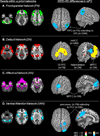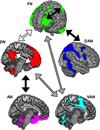Large-Scale Network Dysfunction in Major Depressive Disorder: A Meta-analysis of Resting-State Functional Connectivity - PubMed (original) (raw)
Meta-Analysis
Large-Scale Network Dysfunction in Major Depressive Disorder: A Meta-analysis of Resting-State Functional Connectivity
Roselinde H Kaiser et al. JAMA Psychiatry. 2015 Jun.
Abstract
Importance: Major depressive disorder (MDD) has been linked to imbalanced communication among large-scale brain networks, as reflected by abnormal resting-state functional connectivity (rsFC). However, given variable methods and results across studies, identifying consistent patterns of network dysfunction in MDD has been elusive.
Objective: To investigate network dysfunction in MDD through a meta-analysis of rsFC studies.
Data sources: Seed-based voxelwise rsFC studies comparing individuals with MDD with healthy controls (published before June 30, 2014) were retrieved from electronic databases (PubMed, Web of Science, and EMBASE) and authors contacted for additional data.
Study selection: Twenty-seven seed-based voxel-wise rsFC data sets from 25 publications (556 individuals with MDD and 518 healthy controls) were included in the meta-analysis.
Data extraction and synthesis: Coordinates of seed regions of interest and between-group effects were extracted. Seeds were categorized into seed-networks by their location within a priori functional networks. Multilevel kernel density analysis of between-group effects identified brain systems in which MDD was associated with hyperconnectivity (increased positive or reduced negative connectivity) or hypoconnectivity (increased negative or reduced positive connectivity) with each seed-network.
Results: Major depressive disorder was characterized by hypoconnectivity within the frontoparietal network, a set of regions involved in cognitive control of attention and emotion regulation, and hypoconnectivity between frontoparietal systems and parietal regions of the dorsal attention network involved in attending to the external environment. Major depressive disorder was also associated with hyperconnectivity within the default network, a network believed to support internally oriented and self-referential thought, and hyperconnectivity between frontoparietal control systems and regions of the default network. Finally, the MDD groups exhibited hypoconnectivity between neural systems involved in processing emotion or salience and midline cortical regions that may mediate top-down regulation of such functions.
Conclusions and relevance: Reduced connectivity within frontoparietal control systems and imbalanced connectivity between control systems and networks involved in internal or external attention may reflect depressive biases toward internal thoughts at the cost of engaging with the external world. Meanwhile, altered connectivity between neural systems involved in cognitive control and those that support salience or emotion processing may relate to deficits regulating mood. These findings provide an empirical foundation for a neurocognitive model in which network dysfunction underlies core cognitive and affective abnormalities in depression.
Conflict of interest statement
Conflicts of Interest:
No part of this study constitutes a conflict of interest for the corresponding author or coauthors.
Figures
Figure 1. Results of meta-analysis
Seed regions-of-interest categorized by a priori functional network (left panels), and results of meta-analysis (right panels) showing regions in which abnormal resting-state functional connectivity (rsFC) was observed in individuals with Major Depressive Disorder (MDD) as compared to healthy controls (HC). (A) MDD individuals exhibited hypoconnectivity within the frontoparietal network (FN), between FN seeds and posterior parietal cortex (PPC); and hypoconnectivity between FN seeds and a region of superior parietal lobule (SPL) within the dorsal attention network (DAN). (B) MDD was associated with hyperconnectivity within the default network (DN), between DN seeds and medial prefrontal cortex (MPFC) and hippocampus; and hyperconnectivity between DN seeds and dorsolateral prefrontal cortex (DLPFC), a key hub of FN. (C) MDD was linked to hypoconnectivity between seeds in the affective network (AN) and regions of MPFC. (D) MDD was related to hypoconnectivity between VAN seeds and precuneus extending to occipital and posterior cingulate cortex (PCC), although post-hoc analyses also indicated hyperconnectivity between VAN and posterior regions. Shown here are results of both height-based (hb) thresholding (proportion of studies reporting an effect at that voxel exceeds chance) and extent-based (eb) thresholding (proportion of studies reporting an effect at contiguous voxels exceeds chance), all results significant at p<0.05, corrected for Family-Wise Error-Rate.
Figure 2. A neurocognitive network model of Major Depressive Disorder
Reduced connectivity among regions of frontoparietal network (FN) may underlie general deficits in cognitive control, while increased connectivity between FN and default network (DN), and reduced connectivity between FN and dorsal attention network (DAN), may reflect biases towards ruminative thoughts at the cost of attending to the external world. Meanwhile, reduced connectivity between the affective network (AN) and MPFC regions that mediate top-down regulation may reflect impaired ability to up- or down-regulate emotions or arousal, whereas abnormal connectivity between the ventral attention network (VAN) and posterior regions may reflect altered or biased salience monitoring. (Black arrows represent hypoconnectivity in MDD; white arrows represent hyperconnectivity in MDD; gray arrows represent generally abnormal (both hypo- and hyper-) connectivity in MDD).
Similar articles
- Impairments of large-scale functional networks in attention-deficit/hyperactivity disorder: a meta-analysis of resting-state functional connectivity.
Gao Y, Shuai D, Bu X, Hu X, Tang S, Zhang L, Li H, Hu X, Lu L, Gong Q, Huang X. Gao Y, et al. Psychol Med. 2019 Nov;49(15):2475-2485. doi: 10.1017/S003329171900237X. Epub 2019 Sep 10. Psychol Med. 2019. PMID: 31500674 Review. - Large-scale network dysfunction in α-Synucleinopathy: A meta-analysis of resting-state functional connectivity.
Tang S, Wang Y, Liu Y, Chau SW, Chan JW, Chu WC, Abrigo JM, Mok VC, Wing YK. Tang S, et al. EBioMedicine. 2022 Mar;77:103915. doi: 10.1016/j.ebiom.2022.103915. Epub 2022 Mar 5. EBioMedicine. 2022. PMID: 35259574 Free PMC article. - Abnormal amygdala resting-state functional connectivity in adults and adolescents with major depressive disorder: A comparative meta-analysis.
Tang S, Lu L, Zhang L, Hu X, Bu X, Li H, Hu X, Gao Y, Zeng Z, Gong Q, Huang X. Tang S, et al. EBioMedicine. 2018 Oct;36:436-445. doi: 10.1016/j.ebiom.2018.09.010. Epub 2018 Oct 11. EBioMedicine. 2018. PMID: 30316866 Free PMC article. - Dysfunction of Large-Scale Brain Networks in Schizophrenia: A Meta-analysis of Resting-State Functional Connectivity.
Dong D, Wang Y, Chang X, Luo C, Yao D. Dong D, et al. Schizophr Bull. 2018 Jan 13;44(1):168-181. doi: 10.1093/schbul/sbx034. Schizophr Bull. 2018. PMID: 28338943 Free PMC article. - Large-scale network dysfunction in youths with Internet gaming disorder: a meta-analysis of resting-state functional connectivity studies.
Yan H, Li Q, Yu K, Zhao G. Yan H, et al. Prog Neuropsychopharmacol Biol Psychiatry. 2021 Jul 13;109:110242. doi: 10.1016/j.pnpbp.2021.110242. Epub 2021 Jan 9. Prog Neuropsychopharmacol Biol Psychiatry. 2021. PMID: 33434637 Review.
Cited by
- Common neurobiological correlates of resilience and personality traits within the triple resting-state brain networks assessed by 7-Tesla ultra-high field MRI.
Altinok DCA, Rajkumar R, Nießen D, Sbaihat H, Kersey M, Shah NJ, Veselinović T, Neuner I. Altinok DCA, et al. Sci Rep. 2021 Jun 2;11(1):11564. doi: 10.1038/s41598-021-91056-y. Sci Rep. 2021. PMID: 34079001 Free PMC article. - Aberrant Resting-State Cerebellar-Cerebral Functional Connectivity in Unmedicated Patients With Obsessive-Compulsive Disorder.
Murayama K, Tomiyama H, Tsuruta S, Ohono A, Kang M, Hasuzawa S, Mizobe T, Kato K, Togao O, Hiwatashi A, Nakao T. Murayama K, et al. Front Psychiatry. 2021 Apr 23;12:659616. doi: 10.3389/fpsyt.2021.659616. eCollection 2021. Front Psychiatry. 2021. PMID: 33967861 Free PMC article. - A Novel Framework for Network-Targeted Neuropsychiatric Deep Brain Stimulation.
Allawala A, Bijanki KR, Goodman W, Cohn JF, Viswanathan A, Yoshor D, Borton DA, Pouratian N, Sheth SA. Allawala A, et al. Neurosurgery. 2021 Jul 15;89(2):E116-E121. doi: 10.1093/neuros/nyab112. Neurosurgery. 2021. PMID: 33913499 Free PMC article. - Reduced global functional connectivity of the medial prefrontal cortex in major depressive disorder.
Murrough JW, Abdallah CG, Anticevic A, Collins KA, Geha P, Averill LA, Schwartz J, DeWilde KE, Averill C, Jia-Wei Yang G, Wong E, Tang CY, Krystal JH, Iosifescu DV, Charney DS. Murrough JW, et al. Hum Brain Mapp. 2016 Sep;37(9):3214-23. doi: 10.1002/hbm.23235. Epub 2016 May 4. Hum Brain Mapp. 2016. PMID: 27144347 Free PMC article.
References
- Substance Abuse and Mental Health Services Administration S. Results from the 2012 National Survey on Drug Use and Health: Mental Health Findings. Rockville, MD: Substance Abuse and Mental Health Services Administration; 2013.
- World Health Organization W. World Health Statistics. Geneva, Switzerland: WHO Press; 2010.
Publication types
MeSH terms
Grants and funding
- R01 MH068376/MH/NIMH NIH HHS/United States
- F32 MH106262/MH/NIMH NIH HHS/United States
- R01MH101521/MH/NIMH NIH HHS/United States
- R01 MH076136/MH/NIMH NIH HHS/United States
- R01 DA035484/DA/NIDA NIH HHS/United States
- R01 MH101521/MH/NIMH NIH HHS/United States
LinkOut - more resources
Full Text Sources
Other Literature Sources

